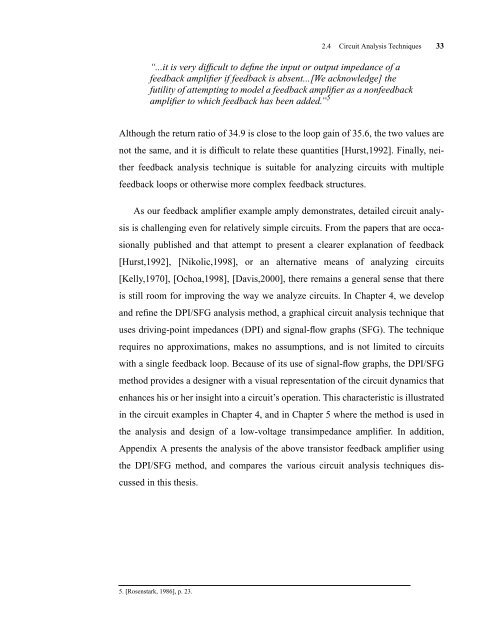CMOS Optical Preamplifier Design Using Graphical Circuit Analysis
CMOS Optical Preamplifier Design Using Graphical Circuit Analysis
CMOS Optical Preamplifier Design Using Graphical Circuit Analysis
Create successful ePaper yourself
Turn your PDF publications into a flip-book with our unique Google optimized e-Paper software.
2.4 <strong>Circuit</strong> <strong>Analysis</strong> Techniques 33<br />
“...it is very difficult to define the input or output impedance of a<br />
feedback amplifier if feedback is absent...[We acknowledge] the<br />
futility of attempting to model a feedback amplifier as a nonfeedback<br />
amplifier to which feedback has been added.” 5<br />
Although the return ratio of 34.9 is close to the loop gain of 35.6, the two values are<br />
not the same, and it is difficult to relate these quantities [Hurst,1992]. Finally, nei-<br />
ther feedback analysis technique is suitable for analyzing circuits with multiple<br />
feedback loops or otherwise more complex feedback structures.<br />
As our feedback amplifier example amply demonstrates, detailed circuit analy-<br />
sis is challenging even for relatively simple circuits. From the papers that are occa-<br />
sionally published and that attempt to present a clearer explanation of feedback<br />
[Hurst,1992], [Nikolic,1998], or an alternative means of analyzing circuits<br />
[Kelly,1970], [Ochoa,1998], [Davis,2000], there remains a general sense that there<br />
is still room for improving the way we analyze circuits. In Chapter 4, we develop<br />
and refine the DPI/SFG analysis method, a graphical circuit analysis technique that<br />
uses driving-point impedances (DPI) and signal-flow graphs (SFG). The technique<br />
requires no approximations, makes no assumptions, and is not limited to circuits<br />
with a single feedback loop. Because of its use of signal-flow graphs, the DPI/SFG<br />
method provides a designer with a visual representation of the circuit dynamics that<br />
enhances his or her insight into a circuit’s operation. This characteristic is illustrated<br />
in the circuit examples in Chapter 4, and in Chapter 5 where the method is used in<br />
the analysis and design of a low-voltage transimpedance amplifier. In addition,<br />
Appendix A presents the analysis of the above transistor feedback amplifier using<br />
the DPI/SFG method, and compares the various circuit analysis techniques dis-<br />
cussed in this thesis.<br />
5. [Rosenstark, 1986], p. 23.














